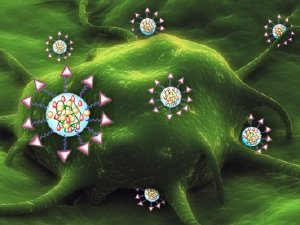Oct 5 2010
In recent years, studies have shown that for many types of cancer, combination drug therapy is more effective than single drugs. However, it is usually difficult to get the right amount of each drug to the tumor. Now researchers at MIT and Brigham and Women’s Hospital have developed a nanoparticle that can deliver precise doses of two or more drugs to prostate cancer cells.
In a study appearing online this week in the Proceedings of the National Academy of Sciences, the researchers tailored their particles to deliver cisplatin and docetaxel, two drugs commonly used to treat many different types of cancer.
 Drug-carrying nanoparticles designed by MIT and Brigham and Women's Hospital researchers are decorated with tags that bind to molecules found on the surface of tumor cells.
Nanoparticle images: MIT/Brigham and Women's Hospital
Drug-carrying nanoparticles designed by MIT and Brigham and Women's Hospital researchers are decorated with tags that bind to molecules found on the surface of tumor cells.
Nanoparticle images: MIT/Brigham and Women's Hospital
Such particles could improve the effectiveness of chemotherapy while minimizing the side effects normally seen with these drugs, according to the researchers. They could also be adapted to target cancers other than prostate cancer, or even to deliver drugs for other diseases that require combination therapy.
To build their nanoparticles, the researchers developed a new strategy that allowed them to incorporate drugs with very different physical properties, which had been impossible with previous drug-delivering nanoparticles. In earlier generations of nanoparticles, drug molecules were encapsulated in a polymer coating. Using those particles, hydrophobic (water-repelling) drugs, such as docetaxel, and hydrophilic (water-attracting) drugs, such as cisplatin, can’t be carried together, nor can drugs with different charges.
“With the old way, you can only do it if the two drugs are physically and chemically similar,” said Omid Farokhzad, director of the Laboratory of Nanomedicine and Biomaterials at Brigham and Women’s Hospital and a senior author of the paper. “With this way, you can put in drugs that are relatively different from each other.”
MIT Institute Professor Robert Langer and Stephen Lippard, the Arthur Amos Noyes Professor of Chemistry at MIT, are also senior authors of the paper. Former Brigham and Women’s postdoctoral associate Nagesh Kolishetti is the lead author. The research was funded by the National Cancer Institute, National Institute of Biomedical Imaging and Bioengineering, and the David Koch Prostate Cancer Foundation.
Precise control
With the researchers’ new technique, called “drug-polymer blending,” drug molecules are hung like pendants from individual units of the polymer, before the units assemble into a polymer nanoparticle. That allows the researchers to precisely control the ratio of drugs loaded into the particle. They can also control the rate at which each drug will be released once it enters a tumor cell.
The new particles offer a much-needed ability to fine-tune drug combinations and personalize treatment for individual patients, said Michael Pishko, professor of chemical engineering at Texas A&M University, who was not involved in this study. “They’re right on the money in terms of what these systems should look like,” he said.
Once the drugs are loaded into the nanoparticle, the researchers add a tag that binds to a molecule called PSMA, which is located on the surfaces of most prostate tumor cells. This tag allows the nanoparticles to go directly to their target, bypassing healthy tissues and potentially reducing the side effects caused by most chemotherapy drugs. That could permit doctors to give much higher doses to a larger number of patients.
The researchers have filed for a patent on the polymer-blending fabrication technique, and are now testing the drug-delivering particles in animals. Once they gather enough animal data, which could take a few years, they hope to begin clinical trials.